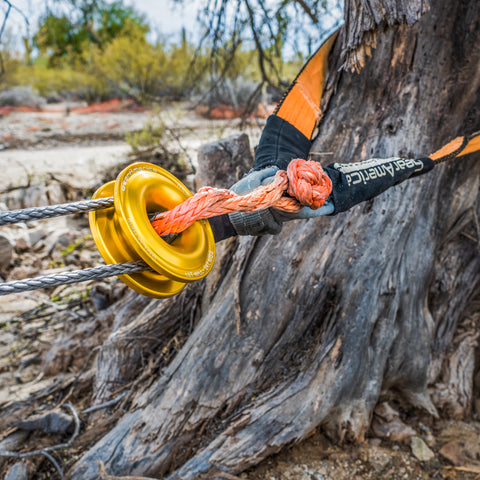To make a winch ground anchor, first dig a hole in the ground using a shovel. Then, insert a chain or sturdy rope into the hole, forming a loop, and secure it with a sturdy anchor point.
Why Use A Winch Ground Anchor For Off-Road Adventures
Using a winch ground anchor for off-road adventures offers several benefits. Firstly, it is crucial to secure your vehicle during off-road activities to prevent accidents and enhance safety. A winch ground anchor provides a strong and stable point of attachment, allowing you to securely anchor your vehicle in place. This ensures that your vehicle remains stationary, even when faced with challenging terrains or steep inclines.
Moreover, the winch ground anchor increases the pulling capacity of your winch by providing a solid anchor point. This is particularly useful when recovering stuck vehicles or pulling heavy loads. The anchor’s sturdy construction and reliable grip on the ground help to distribute the load evenly, reducing the risk of slippage or damage to your vehicle or winch.
Choosing The Right Materials For Your Winch Ground Anchor
When it comes to making a winch ground anchor, it is essential to select the right materials that will ensure durability and strength. Understanding the different materials available can help you make an informed decision for your specific needs.
| Materials | Durability | Strength |
|---|---|---|
| Steel | High | Very strong |
| Aluminum | Moderate | Relatively strong |
| Polyurethane | Low | Less strong |
Steel is a popular choice due to its high durability and very strong nature. However, it may be heavier and more expensive. Aluminum is lighter and relatively strong, but its durability may be moderate. On the other hand, polyurethane, although less strong and less durable, can be a cost-effective option if strength is not a critical requirement.
Remember to evaluate the specific needs of your winch ground anchor before selecting the materials, ensuring they align with the desired durability and strength for optimal performance.
Designing And Building Your Winch Ground Anchor
Designing and building your own winch ground anchor requires careful consideration of its size and weight capacity to ensure its effectiveness. The anchor’s size should be determined by the weight of the vehicle or load it needs to support. It is crucial to identify a suitable location for installation, taking into account factors such as soil composition and accessibility for the winch cable.
To construct your own winch ground anchor, follow this step-by-step guide:
1. Dig a hole that is deep and wide enough to accommodate the anchor.
2. Insert a sturdy pipe or rod into the hole, ensuring it extends above ground level.
3. Surround the pipe with a solid mix of concrete, ensuring it forms a stable foundation.
4. Allow the concrete to cure and harden fully.
5. Attach a heavy-duty attachment point, such as a D-ring, to the top of the anchor.
6. Test the anchor by applying force or weight to ensure its stability before use.
By following these guidelines, you can create a reliable winch ground anchor that will assist in various off-road recovery situations.
Installing Your Winch Ground Anchor Properly
Installing your winch ground anchor properly involves several important steps to ensure a secure and reliable anchor point. First, you need to prepare the installation site. This includes clearing away any debris or obstructions and selecting a suitable location for your anchor.
Next, dig a hole that is deep and wide enough to accommodate the anchor. Make sure to remove any loose soil or rocks from the hole. Once the hole is prepared, position the anchor in the hole and ensure it is level and stable.
Finally, secure the anchor using the appropriate tools and techniques. This may involve using concrete, soil compactors, or anchor bolts, depending on the type of anchor you are installing. Follow the manufacturer’s instructions carefully to ensure a secure installation.
Maintaining And Inspecting Your Winch Ground Anchor
Maintaining and inspecting your winch ground anchor is essential for ensuring its effectiveness. Regular maintenance is key to keeping your anchor in top shape. Conduct thorough inspections to identify any signs of wear and tear. Look for cracks, deformities, or loose parts. If you find any damage, it’s important to replace or repair the affected parts immediately to maintain optimal performance.
Tips And Tricks For Using Your Winch Ground Anchor
When it comes to using a winch ground anchor, there are a few tips and tricks that can help maximize its effectiveness. Setting up the anchor correctly is crucial for stability and safety. Make sure to choose a suitable location and secure the anchor firmly into the ground. To further enhance stability, consider using additional accessories like anchor chains or straps. These can provide extra support and prevent any movement or slippage.
Minimizing risks is also important when using a winch ground anchor. Always inspect the anchor and its components before each use, checking for any signs of wear or damage. It’s also essential to use the correct winching technique to avoid putting unnecessary strain on the anchor.
For enhanced performance, consider making modifications to your winch ground anchor. This could include adding reinforcement plates or upgrading the anchor’s materials for increased durability. These modifications can provide added strength and longevity.
Troubleshooting And Common Issues With Winch Ground Anchors
| Troubleshooting and Common Issues with Winch Ground Anchors | ||||||
|

Credit: www.gearamerica.com
Frequently Asked Questions Of How To Make A Winch Ground Anchor
How Does A Winch Ground Anchor Work?
A winch ground anchor works by securely holding the winch in place, providing stability and preventing it from moving while under load. It uses the force of the ground to create resistance, allowing the winch to pull heavy objects without slipping or losing traction.
What Are The Key Components Of A Winch Ground Anchor?
The key components of a winch ground anchor include an anchor plate or stake, a strong attachment point, and a reliable connection to the winch. These components work together to ensure that the anchor remains sturdy and can withstand the force exerted by the winch.
How Do I Make A Winch Ground Anchor?
To make a winch ground anchor, you will need a sturdy metal stake or anchor plate, a drill or hammer to secure the anchor in the ground, and a sturdy attachment point. Follow the manufacturer’s instructions to properly secure the anchor and ensure it can withstand the force of the winch.
Can I Use A Winch Ground Anchor For Different Terrain Types?
Yes, you can use a winch ground anchor for different terrain types. However, it is important to choose the right type of anchor and installation method for the specific terrain you will be working with. Some anchors may work better in soft or sandy soil, while others are more suited for rocky or hard-packed ground.
Conclusion
To sum it up, building your own winch ground anchor doesn’t have to be complicated. With a few simple steps and materials, you can create a solid and reliable anchor for your winching needs. By following the guidelines provided in this blog post, you can save money and have the satisfaction of a DIY solution.
Remember to always prioritize safety and use proper equipment. Happy winching!
